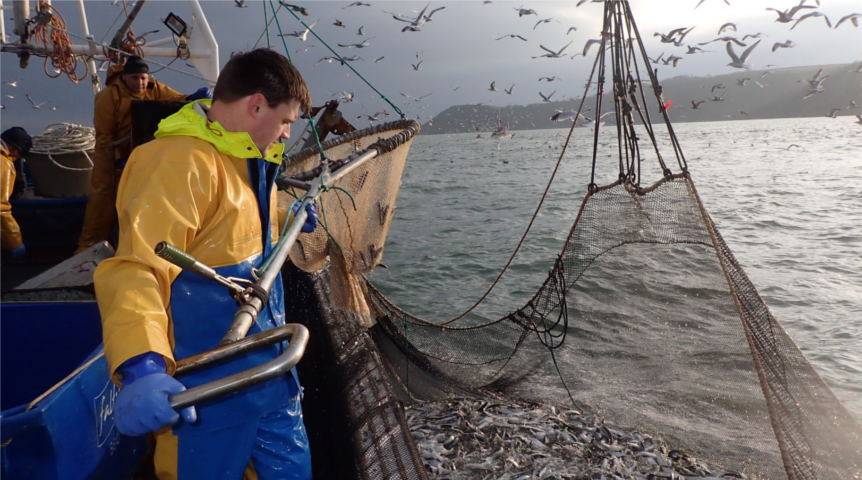The sustainability of Cornwall’s sardine fishery has come under fire in recent months amid reports of large numbers of dead sardines washing ashore in Mounts bay and Whitsand bay. Concerns have also been raised that dolphins and seabirds can sometimes get entangled in the nets, something not previously reported in this specific fishery.
The
sardine ring net fishery in Cornwall has always marketed its high-quality catch on sustainability credentials. Stocks of sardines, although not well studied, appear to be very healthy in Cornish waters these days and fishermen are naturally limited by market demand which they argue prevents them from over fishing. Sardine fishermen generally fish to order, landing only the quantity that they can sell to their buyers.
Ring netting is a relatively low impact fishing method in that the nets are shot over sandy or soft, flat seabeds and the net itself, although it does contact the bottom, is not dragged heavily along the seabed so the impact on seabed life is far less than a trawl or dredge.
I was recently invited to join one of the local ring netters to see how they fish and talk to the crew about their practices. We steamed out of Mevagissey harbour on a sunny calm January afternoon aboard the 12m long wooden multipurpose fishing vessel Galwad-Y-Mor, skippered by young fisherman
Chris Blamey who works alongside his father Peter Blamey, and two other crew men, Brian and Andy. Unlike some sardine fishermen Chris uses a second boat, the Girl Rachel, skippered by Colin, which is used to tow the big boat sideways away from the net when hauling and which makes landing the catch far more efficient and safe.
Figure 1 The Girl Rachel and Mevagissey harbour, sardine seine net in foreground
Figure 2 Skipper Chris Blamey (left) and crewman Andy (right)
Straight after leaving harbour the sonar beneath the boat was picking up marks of fish. No sign of them could be seen from the surface due to the murky green water in the bay which had been stirred up by strong easterlies the day before, but fish were all around us. Some discussion between the skippers and we soon headed off. There was too much slop in Mevagissey bay left over from the easterly so we steamed a short distance north into Duporth within St Austell bay. The water was calmer there and again, the sonar picked out no shortage of large shoals of fish.
Figure 3 Peter Blamey watching the sonar fish finder, red patches are shoals of fish.
The ring net was shot away into the water and the boat rapidly motored in an arc away from it encircling part of the shoal. The ring net itself is 220 metres long and 40 metres deep and it is made of a fine nylon mesh with 12mm holes. The kit for ring netting is hugely expensive but the gear lasts for years and Chris tells me that it is very rare for any net to be lost.
Figure 4 The ringet set in a wide circle – yellow floats on the headrope.
As the circle is closed, I drop a
C-POD over the side. This is a clever piece of technology, an underwater listening device which will pick up and record the sounds of any dolphins in the area.
First the crew draw in the purse line and draw this up to the boat, closing off the bottom of the net. This is why the net has to be 40 metres deep as the mesh forms a wall around the fish and then curves along the seabed back up to the boat.
The men start winding in the net using an overhead hauler. As they pull it in the ring of net becomes smaller. This is where their second boat comes in handy as it attaches a tow rope and it does the job of pulling the main boat sideways away from the net so it doesn’t end up inside the ring. (Some of the purpose built ring net boats have bow thrusters which do the same job.)
Figure 5 Girl Rachel towing the Galwad-Y-Mor sideways, upwind away from the ring net
As the circle of net draws smaller the men are in the stern packing away the black net. The net has to be stored very neatly so that it can be shot away safely next time. It is heavy work.
Figure 6 Hauling in the ringnet - which is flaked into a large net bin behind the wheelhouse
As the net came closer, the seabirds circling got louder. Swirls started to form at the surface of the water and you could just about make out some fish swimming around. A few moments passed and the surface of the water erupted with a fizzing splash. The skipper, who was not sure if there would be many fish in the net, changed his mind and started saying it looked like they may have too much. Quickly the headrope was lowered down beneath the surface and thousands of sardines escaped to freedom, while herring gulls dived to take a few.
Figure 7 The headrope is dipped, allowing a large amount of fish to escape.
After a couple of minutes the tension was increased and the remaining shoal was once again entrapped. The net was drawn in until the surface was a maelstrom of splashing fish. Suddenly the second fishing boat appeared and manoeuvred confidently alongside the net, sandwiching the catch between the two boats.
Figure 8 Girl Rachel comes alongside and trapping the catch between the two boats.
Now the job of emptying the net began. Using huge pan nets, called braillers, each suspended from a crane and lifted by halyards pulled by hydraulic winches, the fishermen scooped 120 kilos of fish out of the water at a time, water and scales flying, and into large insulated blue containers where they were mixed with ice and seawater. In this way, with both boats using a brailler they rapidly emptied the net. The Girl Rachel boat filled their boxes with a total of 4 tonnes, and headed off for home. Chris, his dad and Brian worked away and filled a total of 6 more tonnes in the hold and in boxes aboard of the bigger boat, giving a total catch of 10 tonnes.
Figure 9 Colin starts brailing the fish aboard the Girl Rachel
Figure 10 Girl Rachel steams away and Chris continues emptying the ring net
Figure 11 The last few scoops.
The final fish were scooped out and the net stowed and we steamed for home! A few sardine fell out of the net and were pounced on by a cacophony of herring gulls and gannets, I also spotted a grey seal munching one of the sardines that got away. As well as sardines there were also a few anchovies in the net. Chris explained that the SW anchovies are from a genetically different stock than those caught further south in the Bay of Biscay and that they can command a good price. Mixed in, particularly at the bottom of the net were some mackerel. Mackerel in Cornish waters are protected by the mackerel box, legislation brought in after the mackerel overfishing of the 1980’s that prevents industrial fishing for this species. Ring netters are allowed a bycatch of 15% mackerel only, to protect the stocks. It is often difficult though to avoid mackerel when they are mixed in with the sardines and if more than 15% are caught the fishermen have to slip the catch quickly before they are damaged.

Figure 12 A mixed catch - mainly of sardines but also mackerel and a few anchovies
Figure 13 Anchovy
Chris explained to me how important it is to be careful not to over-load the net and to let fish go soon if you think you have too much in the net. The longer they stay in there, the more damage they sustain and no one wants to unnecessarily kill them. It is easy to see how sometimes, particularly if something goes wrong with the haulers this could happen, and certainly there have been several instances recorded of large numbers of slipped sardines ending up washing ashore on Cornwall’s coastline, and occasionally rotting on the seabed. The fishermen don’t want this to happen and the members of the Cornish Sardine Management Association (CSMA) now have a code of conduct which they are all signed up to, aimed at preventing this happening.
Chris explained that there are currently fifteen boats working sardine ring nets in Cornwall, the number of boats has now been capped at this level, and they are all members of the CSMA. They are all given a quota by their merchants that they are not allowed to exceed. If the merchant only wants 10 tonnes they won’t take more. This prevents the fishermen from over fishing and prevents the market from being oversupplied which would result in a crash in prices.
It was great to see this fishery in action. I was lucky that at this time of year they can fish during the daylight which made it much easier to see what was going on. The sound of the shoal fizzing at the surface was a surreal sight, one that until relatively recently hasn't been seen in Cornish waters since the time of the old pilchard seines, when whole communities depended on the ‘silver darlings’. The CPOD acoustic monitoring device was successfully recovered from under the boat and when the recordings were analysed no dolphin sounds were recorded in the immediate area. But we were pleased to note that this method of deploying the CPOD worked and could be a practical way of recording dolphin activity during ring net operations. Cornwall Wildlife Trust are also keen to carry out further research on the potential interaction between this fishing method and cetaceans next season, particularly the use of acoustic deterrent devices called pingers, which may reduce the chances of ring netters accidentally catching cetaceans such as dolphins and porpoises in their nets.
One thing I was struck by is how quickly the whole operation took place, we were ashore within 3 hours of setting off with ten tonnes of fish. From what I saw, the practices are highly efficient but the fleet does need to adhere to its code of conduct to ensure their practices are indeed sustainable. Sadly, most local people never eat sardines but they are a great source of oily protein. We should all try some of these ‘silver darlings’ as they are good for us, sustainable and cheap!
Matt Slater - Cornwall Good Seafood Guide
Figure 14 Unloading the catch






.jpg)










